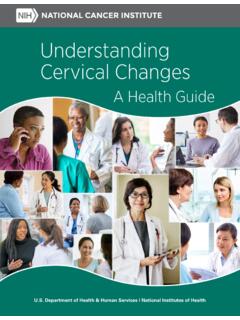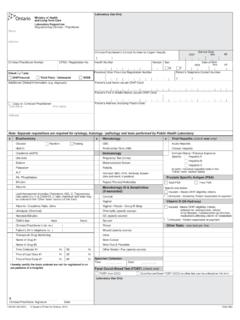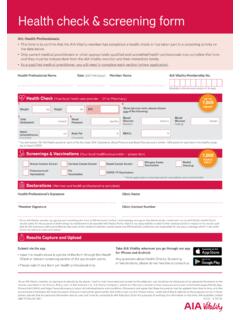Transcription of Supplemental Information and guidance for Vaccination ...
1 Yyy y yySupplemental Information and guidance for Vaccination providers regarding use of 9-valent HPV A 9-valent human papillomavirus (HPV) vaccine (9vHPV, Gardasil 9, Merck & Co.) was licensed for use in females and males in December ,2,3,4 The 9vHPV was the third HPV vaccine licensed in the United States by the Food and Drug Administration (FDA); the other vaccines are bivalent HPV vaccine (2vHPV, Cervarix, GlaxoSmithKline), licensed for use in females, and quadrivalent HPV vaccine (4vHPV, Gardasil, Merck & Co.), licensed for use in females and In February 2015, the Advisory Committee on Immunization Practices (ACIP) recommended 9vHPV as one of three HPV vaccines that can be used for routine Vaccination of females and one of two HPV vaccines for routine Vaccination of After the end of 2016, only 9vHPV will be distributed in the United States. In October 2016, ACIP updated HPV Vaccination recommendations regarding dosing CDC now recommends two doses of HPV vaccine (0, 6 12 month schedule) for persons starting the Vaccination series before the 15th birthday.
2 Three doses of HPV vaccine (0, 1 2, 6 month schedule) continue to be recommended for persons starting the Vaccination series on or after the 15th birthday and for persons with certain immunocompromising conditions. guidance is needed for persons who started the series with 2vHPV or 4vHPV and may be completing the series with 9vHPV. The Information below summarizes some of the recommendations included in ACIP Policy Notes and provides additional Information about the vaccines What are some of the similarities and differences between the three HPV vaccines? Each of the three HPV vaccines is a noninfectious, virus-like particle (VLP) vaccine. 2vHPV, 4vHPV and 9vHPV all target HPV 16 and 18, types that cause approximately 66% of cervical cancers and the majority of other HPV-associated cancers in both women and men in the United Both 4vHPV and 9vHPV also protect against HPV 6 and 11, types that cause anogenital warts. In addition, 9vHPV also targets five additional cancer causing types (HPV 31, 33, 45, 52, and 58) which cause about 15% of cervical cancers.
3 4vHPV and 9vHPV are licensed and recommended for use in females and males; 2vHPV is licensed and recommended for use in females. How many HPV-associated cancers newly diagnosed each year are caused HPV 16/18 and by the five additional types in 9vHPV? An estimated 24,600 HPV-associated cancers are caused by HPV 16 or 18, and 3,800 by the five additional types prevented by 9vHPV. Almost all of the cancers caused by the five additional types occur in women (3,100).8 Information for persons who started an HPV Vaccination series with 4vHPV or 2vHPV If a series was started with 4vHPV or 2vHPV, can it be completed with 9vHPV? Yes, ACIP recommendations state that 9vHPV may be used to continue or complete a series started with a different HPV vaccine product. Are additional 9vHPV doses recommended for a person who started a series with 4vHPV or 2vHPV and completed the series with one or two doses of 9vHPV? There is no ACIP recommendation for additional 9vHPV doses for persons who started the series with 4vHPV or 2vHPV and completed the series with 9vHPV.
4 CS HCVG-15-PTT-107 11/29/2016 National Center for Immunization and Respiratory Diseases Office of the Director yyy yyyyyy y If a series was started with 4vHPV or 2vHPV and will be completed with 9vHPV, what are the intervals for the remaining doses in a three-dose or two-dose series? If the first dose of any HPV vaccine was given before the 15th birthday, Vaccination should be completed according to a two-dose schedule. In a two-dose series, the second dose is recommended 6 12 months after the first dose (0, 6 12 month schedule). If the first dose of any HPV vaccine was given on or after the 15th birthday, Vaccination should be completed according to a three-dose schedule. In a three-dose series, the second dose is recommended 1 2 months after the first dose, and the third dose is recommended six months after the first dose (0, 1 2, 6) month schedule. If a Vaccination schedule is interrupted, vaccine doses do not need to be repeated.
5 Number of recommended doses is based on age at administration of the first dose. If a person desires protection against the five additional types prevented by 9vHPV and has started a series with another HPV vaccine product, what issues should be considered? The majority of all HPV-associated cancers that can be prevented by Vaccination are caused by HPV 16 and HPV 18. These HPV types are prevented by all three vaccines: 2vHPV, 4vHPV and 9vHPV. The benefit of protection against the five additional types targeted by 9vHPV is mostly limited to females for prevention of cervical cancers and precancers. This is because only a small percentage of HPV-associated cancers in males is due to the five additional types prevented by 9vHPV. Available data show no serious safety concerns in persons who were vaccinated with 9vHPV after having received a three-dose series of 4vHPV at least 12 months earlier. cervical cancer screening is recommended beginning at age 21 years and continuing through age 65 years for both vaccinated and unvaccinated What data are available on the number of doses of 9vHPV needed for protection against the 5 additional types for a series started with 4vHPV and completed with 9vHPV?
6 There are no data on efficacy or immunogenicity of one, two or three doses of 9vHPV among persons who have already received only one or two doses of 4vHPV. In an immunogenicity and safety clinical trial, three doses of 9vHPV (administered at 0, 2, and 6 months) were given to females who had already received three doses of 4vHPV; the first dose of 9vHPV was administered 12 36 months After three doses of 9vHPV, over 98% of vaccinees developed antibodies to all five additional types. Antibody was also measured after the first dose of 9vHPV; most but not all vaccinees in the trial developed antibody against all five additional types. Antibody titers were higher after the third dose than after the first dose. Antibody was not measured after the second dose. In a cross-study comparison, geometric mean antibody titers for the five additional HPV types among persons who received three doses of 9vHPV after three doses of 4vHPV were lower than those of persons who received three doses of 9vHPV without prior HPV Vaccination .
7 The clinical significance of the lower antibody titers is not known because there is no established minimum antibody level that correlates with protection. An immunogenicity trial of two doses of 9vHPV has been conducted in HPV vaccine-na ve adolescents aged 9 14 years. In this trial, the two doses were separated by an interval of 6 or 12 Results from this trial demonstrated non-inferior immunogenicity in adolescents age 9 14 years who received a two-dose schedule of HPV vaccine at a 0, 6 month schedule or a 0, 12 month schedule, compared to a three-dose schedule at 0, 2, and 6 months among women in the age group in which efficacy has been demonstrated in clinical trials. Results from this trial support the use of a two-dose schedule in younger adolescents but do not directly address additional 9vHPV Vaccination in persons who already received 4vHPV. yy yyyyyy y What data are available on the safety of 9vHPV Vaccination after a series started with another HPV vaccine product?
8 In an immunogenicity and safety clinical trial, 9vHPV was compared with placebo in females aged 12 26 years who had previously received three doses of 4vHPV. Among the 608 females evaluated who received 9vHPV, there was an acceptable safety Compared to persons in other studies who were vaccinated with 9vHPV and had never received any HPV Vaccination , those who received 9vHPV after a three-dose 4vHPV series had higher rates of injection site swelling and redness. Otherwise, safety profiles of 9vHPV given to HPV vaccine na ve persons and 9vHPV given to persons who had previously completed a three-dose 4vHPV series were generally similar. Information for persons who previously completed a three-dose or two-dose HPV Vaccination series Is additional Vaccination with 9vHPV recommended for persons who have completed a three-dose or two-dose series of either 4vHPV or 2vHPV? There is no ACIP recommendation for additional 9vHPV doses for persons who previously completed a series of 4vHPV or 2vHPV.
9 If a person desires protection against the five additional types prevented by 9vHPV and has completed a series of 4vHPV, what issues should be considered? The majority of all HPV-associated cancers that can be prevented by Vaccination are caused by HPV 16 or 18. These HPV types are prevented by all three HPV vaccines: 2vHPV, 4vHPV and 9vHPV. The benefit of protection against the five additional types targeted by 9vHPV would be mostly limited to females for prevention of cervical cancers and precancers. This is because only a small percentage of HPV-associated cancers in males is due to the five additional types prevented by 9vHPV. Available data show no serious safety concerns in persons who were vaccinated with 9vHPV after having received three doses of 4vHPV. cervical cancer screening is recommended beginning at age 21 years and continuing through age 65 years for both vaccinated and unvaccinated What data are available on efficacy and immunogenicity of 9vHPV when administered after a complete three-dose series of another HPV vaccine product?
10 In an immunogenicity and safety clinical trial, three doses of 9vHPV (administered in 0, 2, 6 month schedule) were given to females who had received three doses of 4vHPV; the first dose of 9vHPV was administered 12 to 36 months After three doses of 9vHPV, over 98% of vaccinees developed antibodies to all 5 additional types. Antibody was also measured after the first dose of 9vHPV; most but not all of the vaccinees in this trial developed antibody against all five additional types. Antibody titers were higher after the third dose than after the first dose. Antibody was not measured after the second dose. In a cross study comparison, geometric antibody titers for the five additional types among persons who received three doses of 9vHPV after three doses of 4vHPV were lower than those of persons who received three doses of 9vHPV without prior HPV Vaccination . The significance of the lower antibody titers is not known because there is no immune correlate of protection.
















